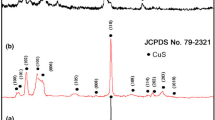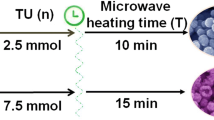Abstract
CuO shuttle-like and flower-like nanocrystals were synthesized through a one-step, low-temperature solution-phase method in the presence of a cation surfactant, hexadecyl trimethyl ammonium bromide. These nanocrystals were studied as an additive for promoting the thermal decomposition of ammonium perchlorate (AP). With the addition of CuO shuttle-like and flower-like nanocrystals, the thermal decomposition temperature of AP decreased. The structure, particle size, and morphology of resulting CuO powders were characterized by X-ray diffraction, scanning electron microscopy, and transmission electron microscopy. Thermogravimetric analysis technique was applied to investigate the thermal decomposition of mixtures of AP and as-prepared CuO nanocrystals.





Similar content being viewed by others
References
Laxmidhar R, Suribabu JTP (2007) Novel CuO nanoparticle catalyzed C–N cross coupling of amines with iodobenzene. Org Lett 17:3396–3399
Zhang MY, Wang LF, Ji HB et al (2007) Cumene liquid oxidation to cumene hydroperoxide over CuO nanoparticle with molecular oxygen under mild condition. J Nat Gas Chem 16:393–398
Li XG, Ma BG, Xu L et al (2007) Catalytic effect of metallic oxides on combustion behavior of high ash coal. Energy Fuels 21:2669–2672
Zhang JT, Liu JF, Peng Q et al (2006) Nearly monodisperse Cu2O and CuO nanospheres: preparation and applications for sensitive gas sensors. Chem Mater 18:867–871
Sambandam A, Wen XG, Yang SH (2005) Room temperature growth of CuO nanorod arrays on copper and their application as a cathode in dye-sensitized solar cells. Mater Chem Phys 93:35–40
Seiichi S, Shogo M, Sinya S et al (2008) Photoelectrochemical characteristics of cells with dyed and undyed nanoporous p-type semiconductor CuO electrodes. J Photochem Photobiol, A Chem 194:143–147
Wang SQ, Zhang JY, Chen CH (2007) Dandelion-like hollow microspheres of CuO as anode material for lithium-ion batteries. Scripta Mater 57:337–340
Gao XP, Bao JL, Pan GL et al (2004) Preparation and electrochemical performance of polycrystalline and single crystalline CuO nanorods as anode materials for Li ion battery. J Phys Chem B 108:5547–5551
Tang KJ, Wang XF, Yan WF et al (2006) Fabrication of superhydrophilic Cu2O and CuO membranes. J Membr Sci 286:279–284
Jarlborg T (2007) Effects of spin–phonon interaction within the CuO plane of high-TC superconductors. Physical C 454:5–14
Chang Y, Zeng HC (2004) Controlled synthesis and self-assembly of single-crystalline CuO nanorods and nanoribbons. Cryst Growth Des 4:397–402
Xiao HM, Zhu LP, Liu XM et al (2007) Anomalous ferromagnetic behavior of CuO nanorods synthesized via hydrothermal method. Solid State Commun 141:431–435
Du GH, Van Tendeloo G (2004) Cu(OH)2 nanowires, CuO nanowires and CuO nanobelts. Chem Phys Lett 393:64–69
Fan XY, Wu ZG, Yan PX et al (2008) Fabrication of well-ordered CuO nanowire arrays by direct oxidation of sputter-deposited Cu3N film. Mater Lett 62:1805–1808
Wang WZ, Zhuang Y, Li L (2008) Structure and size effect of CuO nanowires prepared by low temperature solid-phase process. Mater Lett 62:1724–1726
Wang XQ, Xi GC, Xiong SL et al (2007) Solution-phase synthesis of single-crystal CuO nanoribbons and nanorings. Cryst Growth Des 7:930–934
Liu XW, Geng BY, Du QB et al (2007) Temperature-controlled self-assembled synthesis of CuO, Cu2O and Cu nanoparticles through a single-precursor route. Mater Sci Eng 448:7–14
Zou GF, Li H, Zhang DW et al (2006) Well-aligned arrays of CuO nanoplatelets. J Phys Chem B 110:1632–1637
Liu YL, Liao L, Li JC et al (2007) From copper nanocrystalline to CuO nanoneedle array: synthesis, growth mechanism, and properties. J Phys Chem C 111:5050–5056
Al-Kuhaili MF (2008) Characterization of copper oxide thin films deposited by the thermal evaporation of cuprous oxide (Cu2O). Vacuum 82:623–629
Zheng LK, Liu XJ (2007) Solution-phase synthesis of CuO hierarchical nanosheets at near-neutral pH and near-room temperature. Mater Lett 61:2222–2226
Zhu JW, Bi HP, Wang YP et al (2007) Synthesis of flower-like CuO nanostructures via a simple hydrolysis route. Mater Lett 61:5236–5238
Liu B, Zeng HC (2004) Mesoscale organization of CuO nanoribbons: formation of “Dandelions”. J Am Chem Soc 126:8124–8125
Zhang M, Xu XD, Zhang ML (2008) Hydrothermal synthesis of sheaf-like CuO via ionic liquids. Mater Lett 62:385–388
Liu Y, Chu Y, Zhuo YJ et al (2007) Anion-controlled construction of CuO honeycombs and flowerlike assemblies on copper foils. Cryst Growth Des 7:467–470
Zhang H, Li SZ, Ma XY et al (2008) Controllable growth of dendrite-like CuO nanostructures by ethylene glycol assisted hydrothermal process. Mater Res Bull 43:1291–1296
Cao AM, Monnell JD, Matranga C et al (2007) Hierarchical nanostructured copper oxide and its application in arsenic removal. J Phys Chem C 11:18624–18628
Yuan GQ, Jiang HF, Lin C et al (2007) Shape- and size-controlled electrochemical synthesis of cupric oxide nanocrystals. J Cryst Growth 303:400–406
Zhang YG, Wang ST, Li XB et al (2006) CuO shuttle-like nanocrystals synthesized by oriented attachment. J Cryst Growth 291:196–201
Li D, Leung YH, Djurišić AB et al (2005) CuO nanostructures prepared by a chemical method. J Cryst Growth 282:105–111
Zhang ZP, Sun HP, Shao XQ et al (2005) Three-dimensionally oriented aggregation of a few hundred nanoparticles into monocrystalline architectures. Adv Mater 17:42–47
Acknowledgment
We gratefully acknowledge the support of this research by the Key Technology R&D program of Heilongjiang Province (no.TB06A05), Science Fund for Young Scholar of Harbin City (no. 2004AFQXJ038), and basic research fund for Harbin Engineering University (no. mzj07076).
Author information
Authors and Affiliations
Corresponding author
Rights and permissions
About this article
Cite this article
Wang, J., He, S., Li, Z. et al. Self-assembled CuO nanoarchitectures and their catalytic activity in the thermal decomposition of ammonium perchlorate. Colloid Polym Sci 287, 853–858 (2009). https://doi.org/10.1007/s00396-009-2040-1
Received:
Revised:
Accepted:
Published:
Issue Date:
DOI: https://doi.org/10.1007/s00396-009-2040-1




